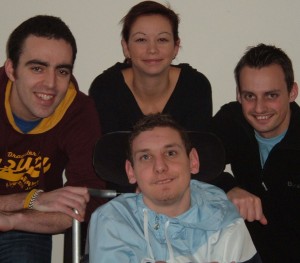An authoritative analysis in today’s Society Guardian of the deepest spending cuts in a generation, which start from Friday. The special issue inludes some sector by sector breakdowns of savings and job losses, including pieces I contributed to the in-depth coverage.
Tag Archives: third sector
The cuts – an alternative
For those who’ve not already seen it, this powerful film presents an alternative to the government’s devastating cuts agenda. It features community groups and anti-cuts campaigners along with Bill Nighy, Radiohead’s Ed O’Brien and Zac Goldsmith MP. Worth watching ahead of this weekend’s demo in London against the cuts.
It Cuts Both Ways…The Alternatives from Oonagh Cousins on Vimeo.
Brighton Marathon’s first wheelchair-using participant
Award-winning sports enthusiast Adam Hayes has already won medals at boccia events, a target ball sport similar to petanque and bowls. As a keen footie fan and Chelsea supporter, the 20-year-old also enjoys a bit of hockey and football too. So it’s no surprise to his mates that he’s participating in the second ever Brighton Marathon next month.
Not only is Adam adding another string to his sporting bow, but he’s making history – Adam will be the first participant in a wheelchair to complete the 26-mile course.
I heard about about Adam after I wrote about the bureaucratic wrangle involving a housemate of his at Fethneys, the Leonard Cheshire Disability home he lives in Worthing, West Sussex.
Joining Adam on the start line on April 10th and pushing him along the course will be three Fethneys care staff, Gavin Parrish, Ollie Orchard and Lucie Hammond.

Adam Hayes, seated, the first wheelchair participant in the Brighton Marathon , pictured with (l-r) marathon teammates Ollie, Lucie and Gavin
The foursome is aiming to raise a target of £2,000 for Fethneys, which accommodates 10 young disabled people at a time, teaching them life skills like cooking, managing bills or cleaning and supporting them towards independent living.
“I feel very honoured to be the first wheelchair user in the whole of the country to take part in the Brighton Marathon,” says Adam. He adds of his boccia playing, “I competed in the GB championships and have won medals in regional and national athletics competitions. I also take part in wheelchair hockey and wheelchair football as a hobby.”
Moving into Fethneys five months ago from a local specialist college for disabled people, Adam says he loves his new home: “The staff here are teaching me the skills I need to live totally independently. Thanks to Fethneys I am really looking forward to living in my own flat in the near future – they are helping me to make my dream become a reality.”
To sponsor Adam, Lucie, Gavin, and Ollie visit their fundraising page.
Leonard Cheshire Disability has places on the 10 mile Great South Run on 30 October 2011. Contact the events team at events@LCDisability.org,
“Each day you spend leaves you with one less, spend them wisely”


Solle Frankel, aged 100
It’s sound advice from Solle yet, as young people, we rarely take the time to stop and listen to the older generation. A survey undertaken late last year by the charity Jewish Care revealed that only a third of Londoners thought that people over the age of 70 were important to society. The charity, which provides health and social care services to hundreds of older people every week, responded in November 2010 with its bold awareness campaign Pearls of Wisdom. The campaign asks the vital question: what can we learn from our elders?
The charity asked fourteen clients to share some valuable bits of advice, drawn from their long and varied lives. The effect was a powerful, unique and at times funny collection of life lessons, ranging from warming affirmations about love – “Get a goodnight kiss, every night” Jerry Cooper, 87 – to astute observations about money – “Don’t buy the things that you can’t afford.. pay your debts”, Jean Nadler, 90.
The fact that older people can be witty, insightful and interesting should go without saying. Yet statistics show that only around half of those aged under 35 have spent quality time with anybody over the age of 70 in the last six months indicating a real reluctance to connect with a social group considered “past it”.
So what’s the thinking behind this? It’s not exactly that we don’t care, but so many of us unthinkingly buy into an established social stereotype: older people are grey, boring and a burden on society. Thankfully, several attempts have made recently to dispel this image. The BBC’s latest hit, When Teenage Meets Old Age, and the recently launched Campaign to End Loneliness, follow a similar track to Pearls. The Campaign to End Loneliness, a collaboration between four different organisations- WRVS, Age UK Oxfordshire, Independent Age and Counsel and Care- wants the ‘Big Society’ to volunteer it’s time to do more for older people. The campaign, which began last month, has highlighted the seriousness of a reality where an average of 10% of our senior citizens feel either “severely lonely” or “always lonely”. Visitors to the campaign’s website are invited to offer their time to an older person or share their tips on how to combat loneliness. It’s not clear yet what the impact has been but the campaign’s report into the UK’s “epidemic of loneliness” is a much needed call to action.
Add to this the success of the website We Are What We Do, an example of original, digital action. We Are What We Do, a not-for-profit company founded by community worker David Robinson, were horrified to discover that two-thirds of Britons now believe that young and older people live in separate worlds. In response, the organisation asked younger people to pledge to make the world a brighter place by undertaking a number of small activities with their seniors. From learning older people’s tried and tested recipes to teaching your granny how to text, the website aims to highlight the myriad ways you can bond across the generations. As a result, nearly 10,000 people have signed up online and the community continues to grow.
At a time when Britain’s population is ageing rapidly and the media seems intent on playing up inter-generational conflict (the supposed battle between the beleagured baby boomers and the spoilt students, as the newspapers like to put it, these new campaigns offer a fresh perspective. It’s also a message that young people are receptive to. As Eitan Amias, a 17-year-old volunteer at one of Jewish Care’s Reubens House residential home in Finchley explains, intergenerational interaction benefits everyone involved: “when visiting the home I feel that I’m not just helping the residents but also myself, as I tend to take that positive energy with me to last the rest of the week”
But for many young people volunteering to spend time with the older generation can offer more than just a glowing feeling of pride. It’s also a valuable way to learn new skills, an increasingly important concern as youth unemployment reaches crisis point.
Indeed, volunteering can be crucial in securing that elusive first job after graduation, as Jamie Field, Jewish Care’s youth and community development officer, discovered. Jamie started working for Jewish Care as a volunteer, aged 15, but the experience he gained through charity work helped him land his current, paid role at the organisation after university.
However, Jamie believes “it’s important to make volunteering cool. It has to be relevant… you could write a newsletter, make a movie or use your skills to help someone use a computer’; young people need to be challenged and inspired and charities can’t be complacent, even in the midst of a recession when young people have more time on their hands to help. Jamie emphasises that young volunteers can use their charity experience not just to get jobs, but also to assist them with their Duke of Edinburgh Awards or to provide additional material for their UCAS forms. So, perhaps it really is time to take Solle’s advice and start spending our time a little more wisely.
Village shops; the tip of the rural social enterprise iceberg
The community-owned and run village shop in the Archers gave rural social enterprises a welcome figurehead but projects in real life provide much more than groceries. Read Saba Salman’s piece on the Guardian social enterprise network site.
The reality behind the mental health strategy rhetoric

As someone who has experienced mental health problems since childhood I was elated to discover, on February 2, deputy prime minister Nick Clegg waxing lyrical about the importance of mental health on breakfast television. It was the new mental health strategy in England, No Health Without Mental Health, a cross-governmental approach to mental health and wellbeing, putting particular emphasis on talking therapies, early intervention and children/young people’s mental health.
£400 million is being invested in mental health services and I applaud the move to improve access to psychological therapies (often described as a ‘Cinderella service’) such as Cognitive Behavioural Therapy (CBT), a type of therapy which works to gradually change a person’s negative thought patterns and behavioural responses over a set period of time.
These types of therapies have been proven to work extremely well for people with mild mental health problems, such as short-term reactive (caused by an external trauma, such as a bereavement or job loss) depression and anxiety. Allowing people access to this type of support at the first onset of symptoms can prevent mental health problems spiralling into more severe forms of mental illness and, if it works, will save the government money as mental health problems are estimated to cost £105bn a year, according to the Centre for Mental Health.
I am pleased children/young people’s mental health is at the forefront of the strategy. Mental health service provision for young people is woefully inadequate, despite research showing half of all people who develop a lifetime mental health problems start to show symptoms at the age of 14. I can attest to this and perhaps with early intervention my mental health would not have deteriorated. Not mentioned, and something which is close to my heart, is how schools can assist with early intervention by training staff in mental health and employing in-school counsellors. My mental health problems were exacerbated by the deficit in knowledge about mental health in my school and as such I feel schools need to be included in discussion on early intervention and preventative measures.
As my elation waned and cynicism set in I pondered some questions: what about those with severe or enduring mental health problems? A short course of CBT is rarely enough when your problems are embedded or not easily identifiable, and I can’t stress enough how difficult it is to get sustained support. Regrettably for the government mental health problems are complex and unwieldy; they can accost you unannounced, be rooted in indescribable traumas and take years to recover from or even manage on a day to day basis. They are highly subjective and as such what is required is a subjective approach, there is no therapeutic panacea.
Talking to other young people, who like me have had mental health problems since a young age, there is a worry psychological therapies will be skewed in favour of CBT over other forms of talking therapies such as psychotherapy, art therapy and group therapy, to name a few. There are myriad treatment options out there but it can be extremely hard to gain access to many of them; perhaps they are not available widely in your area, are expensive or you’re simply told you’re not ‘unwell enough’ yet. The latter can be especially disheartening to hear when you have been physically unable to function for months on end and are desperate for even a semblance of support. There is not one cause for someone developing a mental health problem and while CBT works for many people it is important to note it does not work for everybody and there needs to be access to an array of psychological therapies if these proposals are going to work.
Another question I had after reading about the strategy was about how it can possibly succeed with council cuts affecting mental health services the way they are. In my last blog post I expressed concern about how cuts are affecting voluntary sector mental health services and I come back to this point now. With day centres closing around the country, jobs being lost and the lack of psychiatric beds available mental health provision is not in a good place and I’m left wondering how the government think the NHS can compensate for all these crucial losses.
As a resident of Leeds I was dismayed to hear of the decision to close the Leeds Crisis Centre, Leeds’ only instant access counselling service for people needing immediate support. The rationale behind this is that the service itself isn’t unique and is duplicated within the NHS. With GPs and mental health professionals regularly referring people deemed too ‘high risk’ for NHS services they have come out in force to support the crisis centre and postpone the decision until a rigorous consultation has taken place. I have to wonder how serious the government is about helping people suffering mental distress. Will the rhetoric become reality? Or will, as has become the norm, those of us with mental health problems be left floundering about desperately searching for any kind of support?
Young people putting the record straight
With age, so it’s said, comes wisdom. While I’m not sure this is always true, I do know that with age also comes a creeping inability to know what it’s really like to be a young person today. This is particularly maddening, most under-24s will tell you, when they hear themselves and their issues being aired in the public arena by politicians, policymakers and commentators twice their age.
Working on a special youth edition of Society Guardian, the overriding feeling shared by the young writers involved was one of frustration at the stereotypical view of young people (and if this sounds like a plaintive teenage whine of “no one understands us”, it wasn’t; their complaints about misrepresentation were more valid than that).
So it’s not surprising that in three years of campaigning and going to conferences, seminars and workshops on youth crime, activist Eliza Reberio, 17, says she feels “the research findings and the observations made did not always convey the reality… nothing that was being done or said was making the changes that were required”.
Which is why Reberio and her young peers at the London-based anti-violence campaign Lives Not Knives are planning a youth-led conference, aptly titled Putting the Record Straight, which they want to hold at the end of March.

Reberio explains: “We think it is time that the young people of London had their chance to speak and in fact put the record straight to significant policy makers and make sure not only that their voices are heard, but the right changes are made.” LNK sends peer mentors into schools to share experiences of gang culture and reduce its appeal.
Eliza Reberio explains the aims behind her Lives Not Knives campaign
The government recently announced £18m for tackling knife crime and gun and gang culture following a report into the issue by former EastEnders actor Brooke Kinsella. Kinsella, whose 16-year-old brother, Ben, was stabbed to death in 2008, was appointed as a government adviser on knife crime last year.
Compared to the high-profile Kinsella launch – welcome as it is – Reberio’s has a more grassroots feel to it. She launched LNK in 2007 at the age of 14 because, as she explains, “the toll of teenagers being stabbed due to youth crime and gang culture made an impact on me and others around me.” Expelled from her school for disruptive behaviour, Reberio realised that she was accepting knife crime as nothing out of the ordinary: “I heard about friends being stabbed and I thought it was normal..I would get texts saying someone had been stabbed the night before and I wasn’t shocked. Then I looked at my friends’ little brothers and sisters waking up to those texts and I wanted to change things.”
Printing and selling t-shirts emblazoned with the words “lives not knives” to family and friends, Reberio used the proceeds of the sale to hold a DJ night in her hometown of Croydon, south London, “for youth to have fun without violence” attended by 150 young people.
The campaign mushroomed and corporate donations lead to a booklet written and drawn by young people, depicting their experiences of knife violence and gang culture – thousands of copies were distributed to Croydon schools. LNK now has a 20-strong team of mentors including those who have either lost a friend, been a victim or perpetrator of violent crime or are ex-gang members. Reberio has just won a Diana Award for her work and the project is part-funded by Croydon council, which has made her a local ambassador.
Last year, the young campaigner was picked to feature in the Channel 4 project, Battlefront, which follows a group of 14-21-year-olds as they turn their issues into campaigns.
Now, Reberio’s plan with the youth conference is to work with other community youth led organisations and show organisations such as the police, youth justice staff, politicians, policy makers, adults, parents and teachers “how life really is for young people on the streets of London, how youth violence is affecting our lives and the real changes that need to be made to make London a safer place for young people”.
The young campaigers are now looking for a central London venue and help with everything from organising the event to identifying contacts – young people as well as youth-related organisations – who might benefit from the event.
Anyone who can help or advise should email Reberio livesnotknives@hotmail.com or leave a message on this page.
Small steps towards a big society approach to learning
There is something of a gaping reality chasm between the vision of the big society and its fruition, not to mention growing accusations that the concept is a smokescreen for cuts. The chasm between vision and fruition might be narrowed by better and stronger mechanisms for civic service – or simply more hours in the day, as big society tsar Nat Wei recently demonstrated.
However, one scheme that has slowly and steadily supported and facilitated volunteers to promote an activity – in this case, adult learning – is the Community Learning Champions project. The drive, a joint partnership between NIACE (the National Institute of Adult Continuing Education), WEA, lifelong learning organsiation unionlearn and education consultants Martin Yarnit Associates, involves people who become active in their community by promoting the value of learning to others.
Launched in August 2009 , the three-year £3m Department of Business, Innovation and Skills (BIS) funded scheme ends in March (but of course!) but its ripple effect has been felt at a community level by hundreds of people. More than 1,000 champions should be registered by the end of next month and, if NIACE estimates are right and each champion encourages an average 30 people into learning, 30,000 individuals should be helped into learning as a result.
Champions promote learning among their friends, neighbours, relatives, or workmates; they are trusted as they speak from experience and act as role models to encourage others to take up new skills.
Homeless charity St Mungo’s – which of course has huge concerns about funding cuts – used the Community Learning Champions scheme last year to recruit up to 30 homeless volunteers to become learning champions.
The volunteers, recruited through the charity’s client representative group Outside In which managed the project, encouraged others get involved in learning, anything from gym classes to art workshops.
In the film here, St Mungo’s service user Richard talks about his love of soaking up new knowledge and the difference you can make thanks to a non-classroom learning environment. As he says: “All the time I was homeless, on drugs, this is the sort of thing I always had in my head that when I eventually sorted my life out, it’s the sort of thing I wanted to be doing.”
There’s no place like home
I was really struck by these atmospheric, beautifully shot videos which use characters from the Wizard of Oz to expose the lives of the hidden homeless, taking the film’s iconic line ‘There’s no place like home’ as inspiration.
Produced to show during the charity Crisis’ recent Coldplay Hidden Gigs in Newcastle and Liverpool, they’ve just gone on public release. Dorothy, the Cowardly Lion and the Scarecrow face different aspects of homelessness that most people aren’t aware of.
Dorothy flees violence in a B&B, the Cowardly Lion outsays his welcome on a friend’s sofa and the Scarecrow is a lonely squatter.
If using a vintage Hollywood movie to highlight a contemporary social issue via some pleasing visuals sounds like a totally random stab for publicity, then that’s exactly what it is – and frankly, why not?
As Crisis chief executive Leslie Morphy says: “We are always looking for new ways to bring to attention the hidden crisis of homelessness. We hope these videos make people think about the issue, and hopefully help us in our mission to end homelessness by donating or campaigning for change.”
Official statistics at the end of last year showed rising homelessness. Housing minister Grant Shapps insists that the cuts agenda won’t impact on the homeless, but how, with benefits decimated and support services withering away, can the housing situation of the vulnerable be guaranteed?
The Scarecrow
The Cowardly Lion
Dorothy
The videos were created by Liverpool/London creative agency Mercy, and directed by Nick Brown.
Self-help housing solutions
Self-help housing can help solve employment as well as housing problems – so here’s a belated nudge to a piece by Kate Murray, regular Social Issue blogger, which explores the below-the-radar world of community housing projects in Society Guardian.
